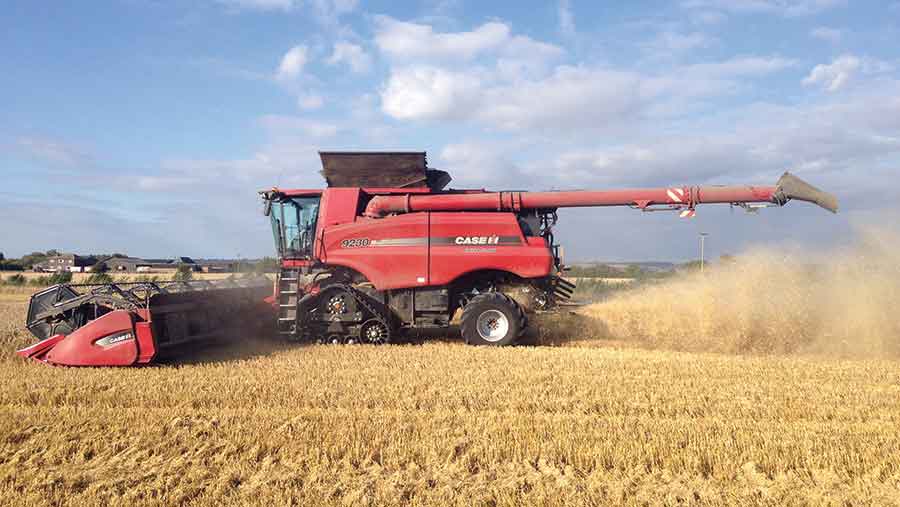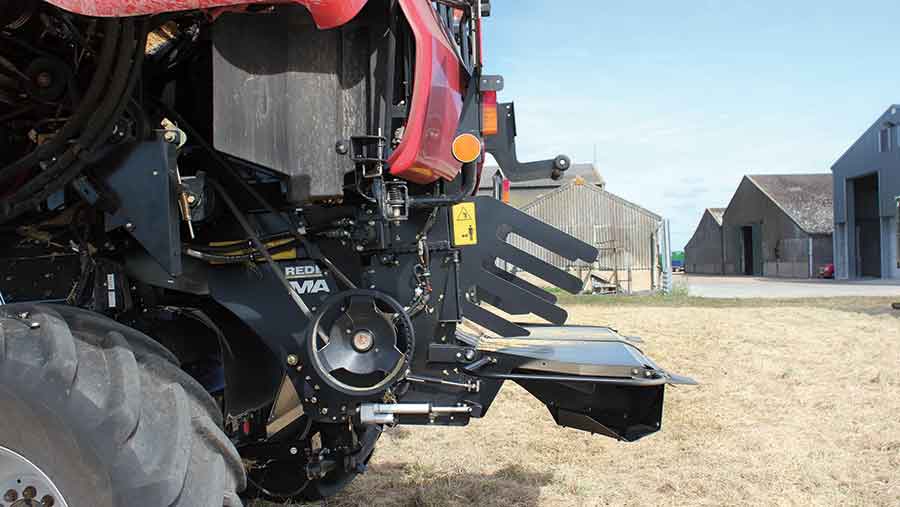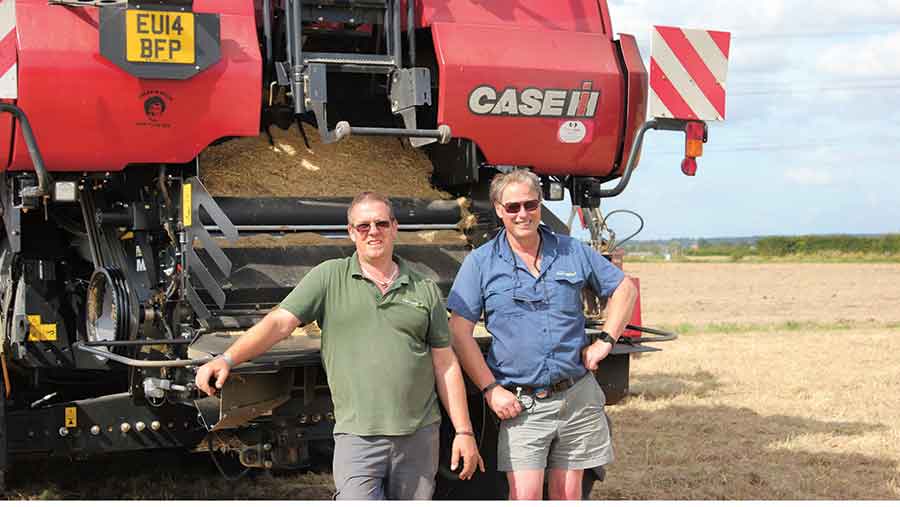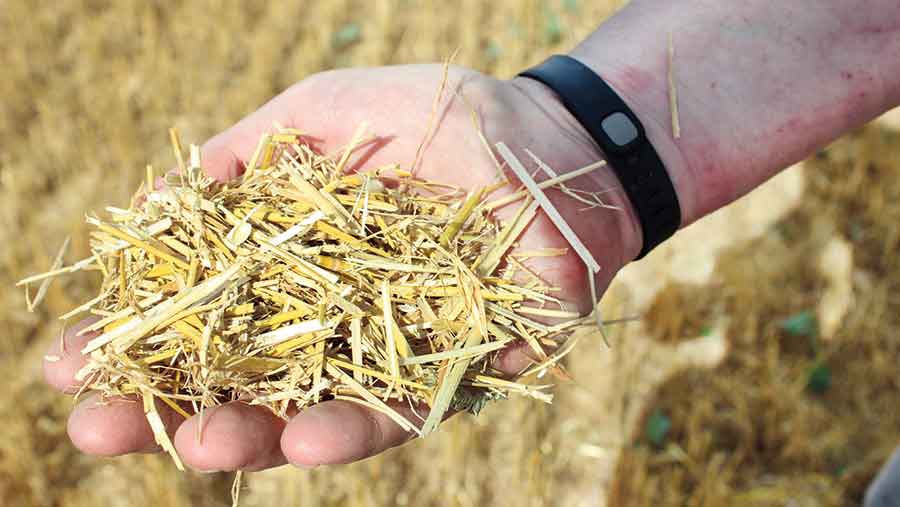Kent farmer rates his retro-fit Redekop combine chopper
Soil health is a top priority for Andrew Cragg of Brooker Farms, Kent, and when it came to upgrading his combine every part from the header to the chopper had to fit into his soil-friendly system.
That meant his fresh-out-the-factory Case IH Axial Flow turned up with tracks instead of tyres and with a 12m header that could slot straight into his controlled traffic arrangement.

However, after making the upgrade he discovered that the Axial Flow’s standard-spec chopper simply wasn’t capable of throwing the sliced straw evenly across the full width of the header.
See also: Norfolk farmer reviews his monster 46cu m Interbenne chaser
Combine replacement
Right from the get-go, working in a 6m/12m/24m controlled traffic system limited his choice of harvester replacements.
“We went to several manufacturers who all bent over backwards to try and help,” says Mr Cragg.
“However, Case was the only one to offer an off-the-shelf header and auger combination that would fit our particular CTF system without any post-purchase upgrades, which meant straying away from the John Deere that is our usual source of new kit.”
After splashing out on a new Axial Flow 9230 and 12m (40ft) header to match, Case IH invited Mr Cragg – and a few other purchasers of the same machine – to a tour of the factory.
There was a resounding opinion among them – the combine was first-rate, but the chopper let it down when in anything but perfect conditions.
They all wanted something that would both chop the straw more finely and spread it across the full width of each pass, even in those early morning and late evening hours when things can start to get a bit sticky.
A few weeks later, Case came up with the solution – the Canadian-made Redekop MAV (Maximum Air Velocity) chopper. Mr Cragg managed to strike a deal whereby Brooker Farms imported it from Canada and the local dealer fitted it, so it was ready for this season’s harvest.
How does it work?
The retro-fit chopper is belt driven and takes its power from the combine’s existing assortment of back-end pulleys.
Unusually, the original chopper remains in place and is used as a discharge beater to pre-chop the residue before firing it into the hood-mounted Redekop.
During the fitting process, all the interior brackets and deflectors must be removed from the combine’s tail to expose the full internal width and allow the rig to be bolted directly to the machine’s chassis.

Very little on the combine actually changes, so the existing actuators and sensors can be used to control and adjust the output via the in-cab terminal and the rear ladder access route isn’t altered, either.
Where a normal chopper depends on the blades to throw the straw from the combine, the design of Redekop’s version means that the outside blades also act as a fan.
The 12 paddle-shaped knives are 150mm long and spin at 3,250rpm, which generates an air flow of up to 150mph.
This air movement doesn’t just blow, but also helps to suck straw and chaff out of the combine before presenting it lengthways to the 96 reversible, carbide-coated blades in the middle.
However, Mr Cragg’s system hasn’t been without its problems. It chewed through belts alarmingly quickly during its debut year until a misaligned pulley was identified as the problem and it was re-fitted ready for this harvest.
It also makes a fair racket when running and drinks a lot of fuel, he says. “Last year I was typically putting in 700 litres a day, but it’s now more like 850 litres because the chopper saps so much power.
“You can also tell when the straw’s a little bit damp or green because it gets through a lot of diesel, but it still does a brilliant job.”
Brooker Farms
Mr Cragg says the Redekop’s super-effective chop doesn’t just stop the cultivators blocking up. “The splitting of stems lengthways as well as crossways allows moisture and bacteria to get at the straw’s internal structure and break it down much quicker than before.

Worms are more easily able to pull it into the soil, boosting organic matter levels and providing the next crop with the best possible environment for germination. Meanwhile, nitrogen can be better used by the growing crop, rather than being locked up by decomposing straw.”
Farm facts
- Name: Brooker Farms, Newchurch, Kent
- Area: 570ha (1,400 acres)
- Soil Type: Silty clay loam
- Cropping: Wheat (350ha), oilseed rape (100ha), peas for seed (100ha)
- Tractors: John Deere 8430, 8215R, 6930, 6920
- Combine: Case 9230 Axial Flow, on damped tracks & 12m (40ft) header
- Sprayer: Househam AR 3500 (24m)
- Telehandler: John Deere 3800
- Cultivation: 8 furrow fully mounted Dowdeswell, 6m Simba Freeflow with Dale conversion, Kuhn 6m power-harrow, Spaldings Flatlift subsoiler, Simba 6m disc + press combination, Cousins 12m Rolls
- Trailers: 2 x Wootton 11t
“We’re already seeing the benefits. Fields we would expect to cultivate twice, we have only needed to do once and with no lumps anywhere on the farm, we won’t need to cultivate at an angle either.”
This summer heralded 10 years of controlled traffic management at the farm, in which time Mr Cragg has noticed a dramatic reduction in fuel use and tractor hours.
“So many people get into precision technology and lose touch of methods for improving soil conditions that have worked fine for thousands of years.
“I still have a plough that gets used when it’s needed, but after being on a CTF system the furrows crumble instead of smear and we see a lot more worms.”
Costs
Brooker Farms isn’t the only arable operation running the Canadian firm’s chopper in the UK.
After the success of other Redekop retro-fits dotted around the country, Case has decided to offer it as an option on new machines.
Typically, the Xtra-Chopping add-on will cost £20,000 including fitting for older harvesters, or £16,000 on new models.

Mr Cragg admits it was expensive, but is convinced it was money well spent. “It’s completely changed our system for the better. We now think of harvesting as the first cultivation process for next year, and it’s vital it’s done right.
“It may cost more to run the combine, but this is outweighed by the saving made in the next cultivation step. It’s changed it into the ideal machine for us so, like our other kit, it’ll stay here for a while now.”

